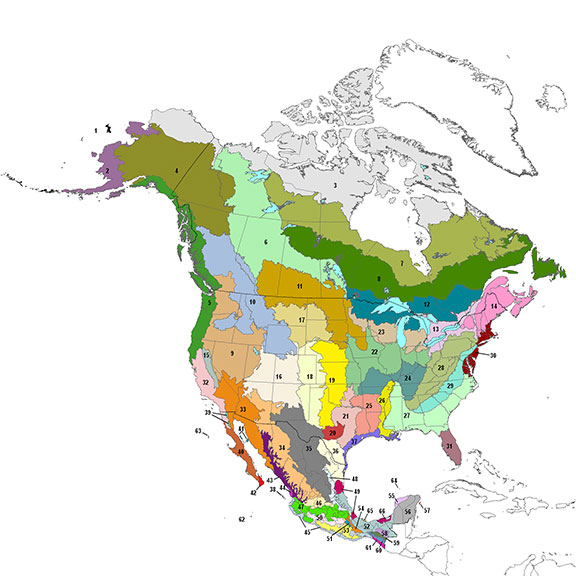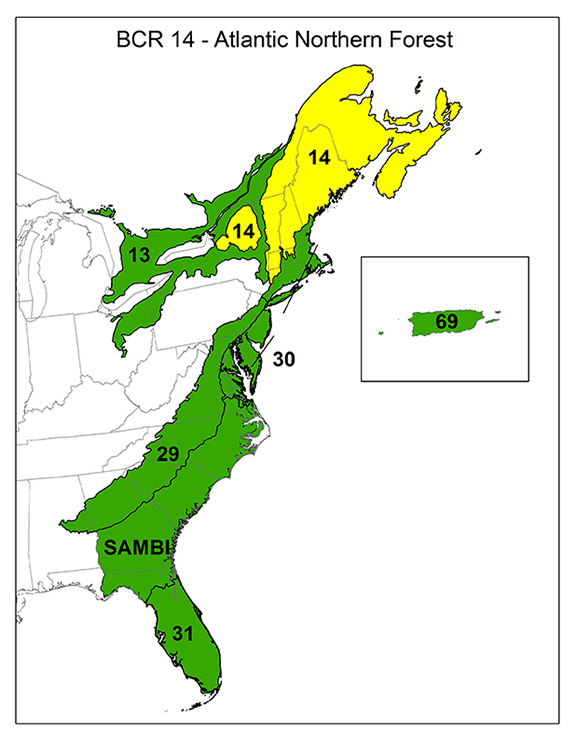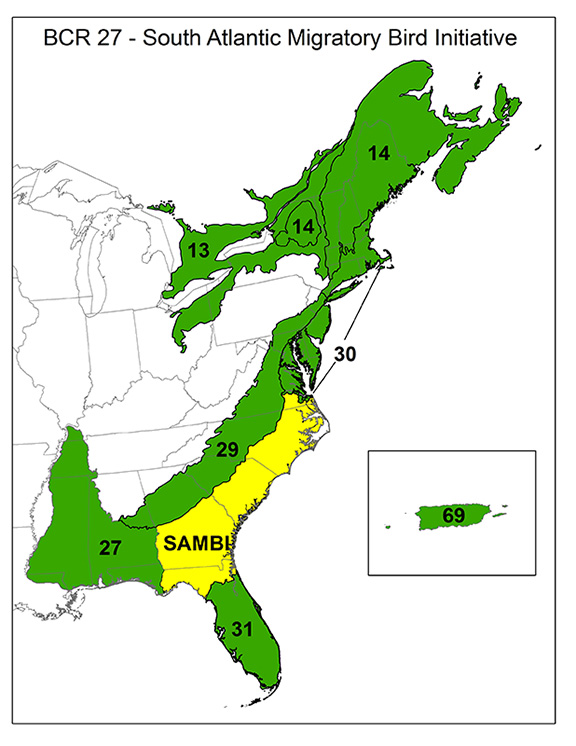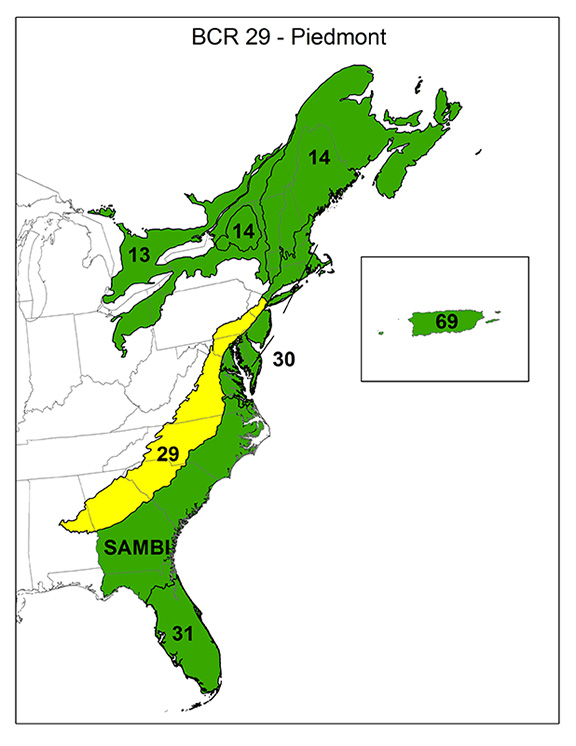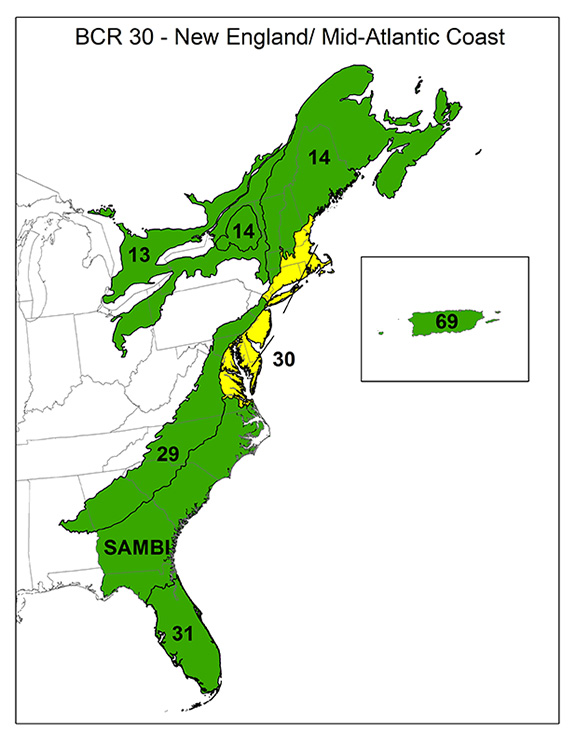BCRs in the Atlantic Coast Joint Venture
Bird Conservation Regions are regions that encompass landscapes having similar bird communities, habitats, and resource issues. They are the fundamental biological units through which NABCI will deliver landscape-scale bird conservation, including evaluation, planning, and in many instances, implementation.
The BCR13 Conservation Plan provides strategic guidance for implementing conservation actions across the region. Developing, funding, and implementing priority research, monitoring, and habitat projects (e.g., protection, restoration, and management), and measuring success toward population and habitat goals in an adaptive management framework are long-term goals of BCR 13 partners.
View more information regarding BCR 13
BCR 13 Coordinator: Mitch_Hartley@fws.gov
Highest priority habitats include coastal areas (saltmarsh, rocky shore, mud flats, and islands), freshwater wetlands, and spruce-fir forest (especially high-elevation forests). The “Atlantic Northern Forest Blueprint” was completed in July, 2005 and is a “living” document; providing a means for linking concepts and detailed information and will be revised as bird conservation moves forward, information is gained, and progress on species conservation occurs. The goal of the BCR Plan is to foster implementation by providing a framework linking projects to conservation goals.
View more information regarding BCR 14
BCR 14 Coordinator: Randy_Dettmers@fws.gov
SAMBI integrates the planning efforts of all the major bird conservation initiatives and single species initiatives into a single resource where common goals and objectives are identified to direct conservation efforts to sustain, maintain, and increase populations of resident, migrating, and wintering birds in the planning area. SAMBI has been one of the most successful regional conservation successes in the United States, and is a model for integrated planning and conservation delivery in North America.
View more information regarding SAMBI
BCR Coordinator: Craig_Watson@fws.gov
This BCR largely consists of upland habitats, with different priorities from north to south, presenting a challenge to implement conservation efforts, particularly since upland conservation program are not as well funded through conservation programs for wetlands in the Joint Venture. Primary efforts in this BCR will focus on conservation of existing forests and grasslands, particularly on private lands, and maintaining or establishing habitat corridors between priority conservation areas.
View more information regarding BCR 29
Priority Bird Species in BCR 29
BCR 29 Coordinator: Craig_Watson@fws.gov
View more information regarding BCR 30
Revised Species Focal Area Maps
BCR Coordinator: Caleb_Spiegel@fws.gov
BCR 30 Habitat Mapping Group
The Habitat Mapping Working group is a consortium of agencies and organizations whose intention is coordinating the collection and use of spatially-explicit habitat information that will enable All-Bird conservation efforts within the Mid-Atlantic Bird Conservation Region. This working group envisions that systematic and standardized approaches to habitat mapping can serve as valuable conservation tools to assess and monitor the relative value of ecological services of landscapes to birds both within and between Bird Conservation Regions.
BCR Contact: mdwils@wm.edu
BCR 30 Regional Monitoring Working Group
The intent of the RMWG is to develop the tools necessary to assess the population status of tidal and freshwater marsh birds. The population information gaps for bird species dependent on these habitat communities have impeded the development of reliable conservation measures. The goal of this working is to assess the populations of tidal and freshwater marsh dependant birds during the breeding and non-breeding periods within and between BCRs, and set objectives to increase and maintain population levels. The group will identify the information gaps, develop regional strategies to initiate and maintain regional monitoring regimes, and develop a network of ground and administrative support for tidal and freshwater marsh birds. Current monitoring of tidal and freshwater marshes do not adequately sample marsh systems. The determination of population and habitat conditions are two key elements in both crafting conservation objectives and effecting positive change towards meeting those objectives.
Contact: Caleb_Spiegel@fws.gov for more information.
Florida Bird Conservation Initiative
The Florida Bird Conservation Initiative was formed as a voluntary public-private partnership that seeks to promote the sustainability of native Florida birds and their habitats through coordinated efforts that strategically address critical needs related to conservation planning, delivery of conservation programs, research and monitoring, education and outreach, and public policy.
Florida Bird Conservation Initiative
Priority Bird List for BCR 31
BCR Contact: Craig_Watson@fws.gov
This region has 284 bird species, 16 of which are endemic. Historical land use and human activities have had severe impacts on these endemic species, as well as habitats for migrating and wintering species from North America. This plan identifies historical and present habitat threats, conservation opportunities, and management strategies to protect important resident and migratory bird in Puerto Rico and the U.S. Virgin Islands.
BCR Contact: Craig_Watson@fws.gov

